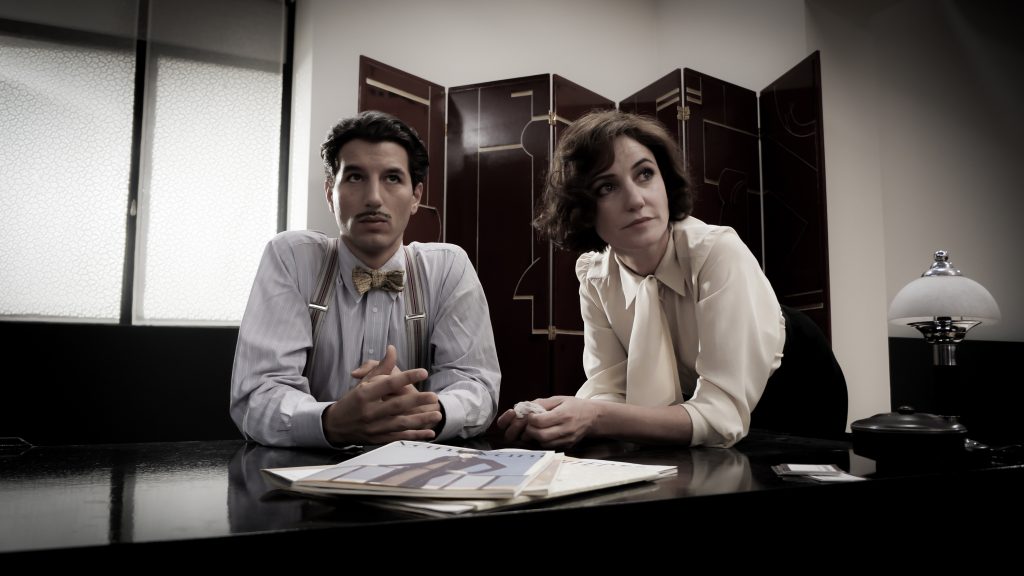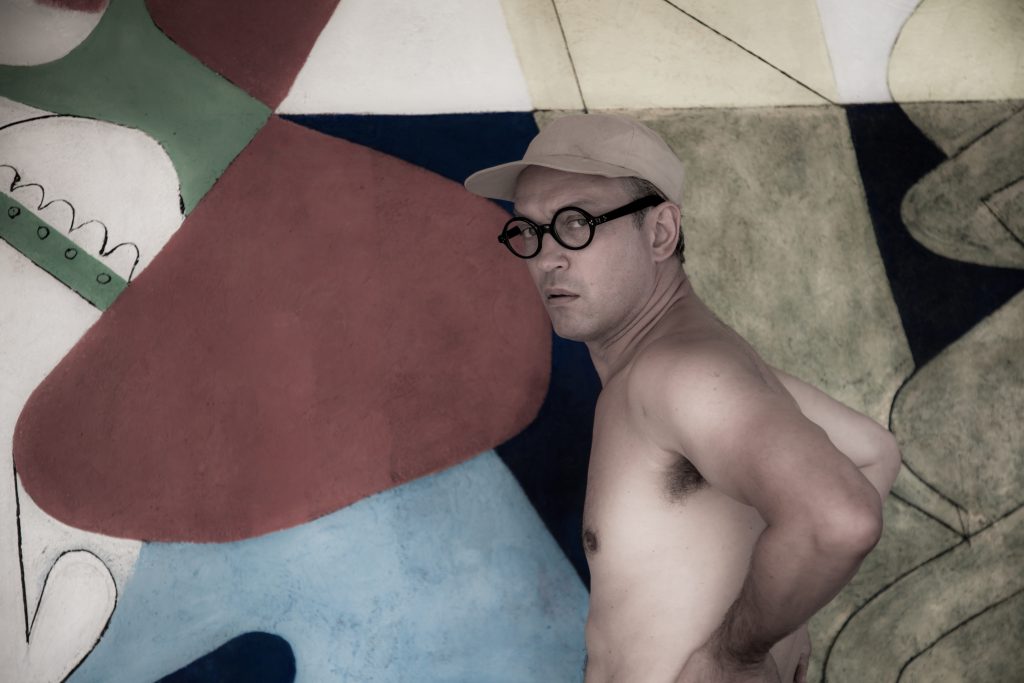June 2, 2020
by Carla Hay

Directed by Mary McGuckian
French and English with subtitles
Culture Representation: Taking place in France from the 1920s to the 1970s, the drama “The Price of Desire” has an all-white cast of characters representing the middle-class and upper-class.
Culture Clash: The film tells the story of Irish architect Eileen Gray and her conflicts over sexism and E-1027, a modernist villa that she designed in Roquebrune-Cap-Martin, France.
Culture Audience: This movie will appeal mostly to people who have an interest in the history of 20th century European modernist architecture.

“The Price of Desire” sounds like it could be the name of a thriller about a crime of passion, but this slow-paced feature film (which is based on a true story) tells how Irish architect/interior designer Eileen Gray (who died in 1976, at the age of 98) was deprived of being credited for much of her work because of sexism in the industry. Written and directed by Mary McGuckian, “The Price of Desire” gets much of the production design correct, but the movie’s turgid tempo might bore people who have absolutely no interest in the history of 20th century European architects.
A great deal of the movie’s cinematography from Stefan von Björn is over-filtered, giving it a dreamy look that movies often use for flashbacks or scenes where people are supposed to be experiencing a heavenly atmosphere. The story of “The Price of Desire” definitely takes place on Earth (France, to be more specific), but this lens filtering is at times distracting. And because Gray was known for her minimalist style, the costume design for the movie is a little too obvious about it, since almost everyone wears clothes in neutral colors, such as white, black, brown or gray.
“The Price of Desire” begins with the Christie’s auction in 2009 that famously sold Gray’s “Dragons” chair for €22 million, which set an auction record for a piece of 20th-century furniture. The movie then flashes back to an elderly and partially blind Eileen (played by Orla Brady) toward the end of her life in the mid-1970s. She is shown a photo of E-1027, a modernist villa that she designed and which was built from 1926 to 1929, in Roquebrune-Cap-Martin, France.
This photo triggers her memories of the story behind E-1027, which is considered her first major architectural work and is now a French national monument. And those memories lead to the movie flashing back to how she met the man who became her lover and who was the muse for E-1027.
Jean Badovici (played by Francesco Scianna) was a Frenchman of Romanian descent who was 15 years younger than Eileen. He met her in 1926 to interview her for L’Architecture Vivante magazine. It’s clear that Jean is immediately attracted to and in awe of Eileen, but she’s somewhat resistant to his obvious interest. When she asks him if he’s a writer or a journalist, he tells her that he’s neither because he’s really an architect.
Eileen is bisexual, so Jean tactfully tries to find out from Eileen how much of her sexual preferences lean toward men. (Near the beginning of the film, Alanis Morissette has a cameo as singer Marisa Damia, one of Eileen’s lovers whose affair with Eileen is over by the time Eileen meets Jean.) Because Eileen and Jean share a passion for architecture and have a growing attraction to each other, they inevitably become lovers, and they soon decide to become work collaborators too.
Eileen tells Jean that she’s not interested in getting married to anyone and that she needs freedom to create and think. Jean tells Eileen, “You’re frittering away your talent on furniture. You’re 46 years old.”
Jean suggests that they design a house together. They name the white modernist villa E-1027, after the initials of their first and last names and where those letters are ranked in the alphabet. “E” standing for Eileen, “10” stands for the “J” in Jean, “2” stands for the “B” in Badovici and “7” stands for the “G” in Gray.
But there’s one big problem: Perhaps in a “love is blind” decision, Eileen paid for the villa to be built and she gave Jean the house’s deed/title. Jean also took credit for designing the villa, which Eileen didn’t mind too much at first when their relationship was going well. They were live-in partners and his career began to thrive because of his association with Eileen, who is shown in the movie as being the brains behind his designs. But then, Eileen caught Jean cheating on her, and they had a bitter breakup not long after the house was completed in 1929.
By the time the breakup happened, Jean had become a close friend Swiss-French architect/artist Le Corbusier (played by Vincent Perez), who had become a titan of the industry as one of the pioneers of modern architecture. Le Corbusier (whose real name was Charles-Édouard Jeanneret) has a sexist attitude toward women in architecture, so he and Eileen inevitably end up having conflicts with each other, even though she says in the movie she remains a “passionate admirer” of Le Corbusier.
Adding insult to injury, after Eileen moved out of E-1027, Le Corbusier painted the walls with several colorful murals, which clashed with the villa’s white palette and minimalist style. To many people, the murals could be considered graffiti. And where is Jean in all of this? He’s taken the breakup with Eileen very hard, so he’s become an alcoholic, and he lets the more powerful Le Corbusier take over the villa.
Although “The Price of Desire” is supposed to be about Eileen Gray, the movie dilutes her perspective by making the character of Le Corbusier speak directly to the audience and share his thoughts. It’s a somewhat odd and distracting choice that McGuckian makes in this film’s narrative.
In real life, Le Corbusier was falsely credited for many years with designing E-1027, until the truth was revealed. Maybe having Le Corbusier narrate the film’s story is McGuckian’s way of demonstrating that even in a movie about Gray, Le Corbusier is trying to dominate and steal her thunder. But viewers of “The Price of Desire” would have to know this part of architectural history to understand this metaphor.
There’s a scene in “The Price of Desire” where Le Corbusier sums up how different he is from Eileen, when he interrupts a scene to talk to the audience about her: “There is so much uncertainty about sex, unless it’s paid for. In art, I can see clearly. In love, not so well. To me, they were incompatible and confused. To [Eileen Gray], they seemed utterly and intrinsically infused.”
Adding to the over-filtered cinematography, “The Price of Desire” also presents much of the movie’s scenes as if the story were a visual romance novel. Many scenes are filmed with too many slow-motion shots, some of which are almost laughable. Even when Eileen is doing the dirty work of breaking ground for the villa, she’s wearing no protective gloves and she’s dressed as if she’s about to go have a picnic in the park.
The movie has depictions of several real-life notable people from the mid-20th century artistic culture. The supporting character who gets the most screen time is artist Fernand Leger (played by Dominique Pinon), who’s a mutual friend of Eileen, Jean and Le Corbusier. Most of Fernand’s scenes consist of him witnessing some of the conflicts between his friends and trying to stay neutral, although in one scene he whispers to Eileen that she deserves to be happy, after she’s disrespected by Jean.
“The Price of Desire” also features cameo portrayals of writer Marcel Proust (played by Arnaud Bronsart); writer/artist Jean Cocteau (played by Fabien Boitiere); and Gray’s lesbian friends Gertrude Stein (played by Sammy Leslie), writer Natalie Barney (played by Natasha Girardi) and art promoter/filmmaker/choreographer Gabrielle Bloch (played by Caitriona Balfe). And it wouldn’t be a movie about high-end art without at least one billionaire. In this case, Aristotle Onassis (played by David Herlihy) makes an appearance.
There’s also a brief depiction author/adventurer Bruce Chatwin (played by Martin Swahey), who visits Eileen in her home toward the end of her life. She just happens to have a photo of Patagonia on her wall, and she mentions that she’s never been there. She then says to Chatwin: “Why don’t you go there for me?” Yes, it’s that kind of movie.
“The Price of Desire” is not a horrible film. It’s just not a very compelling one. The actors in the cast do a serviceable job, but much of the movie’s dialogue just isn’t good enough to elevate, no matter who is speaking the lines.
And worst of all, “The Price of Desire” makes the mistake of having Le Corbusier (who’s portrayed as a misogynistic blowhard) continually interrupt the story to talk directly to the audience. If the point of the movie was to give the proper respect to Gray because she experienced gender discrimination, that intention is ruined by diminishing her perspective and making the story’s narration come from the sexist egomaniac who tried to oppress her in real life.
Giant Pictures released “The Price of Desire” in North America on digital and VOD on June 2, 2020. The movie was already released in the United Kingdom and Ireland in 2016.
https://www.youtube.com/watch?v=xDWjvPXz8MA

